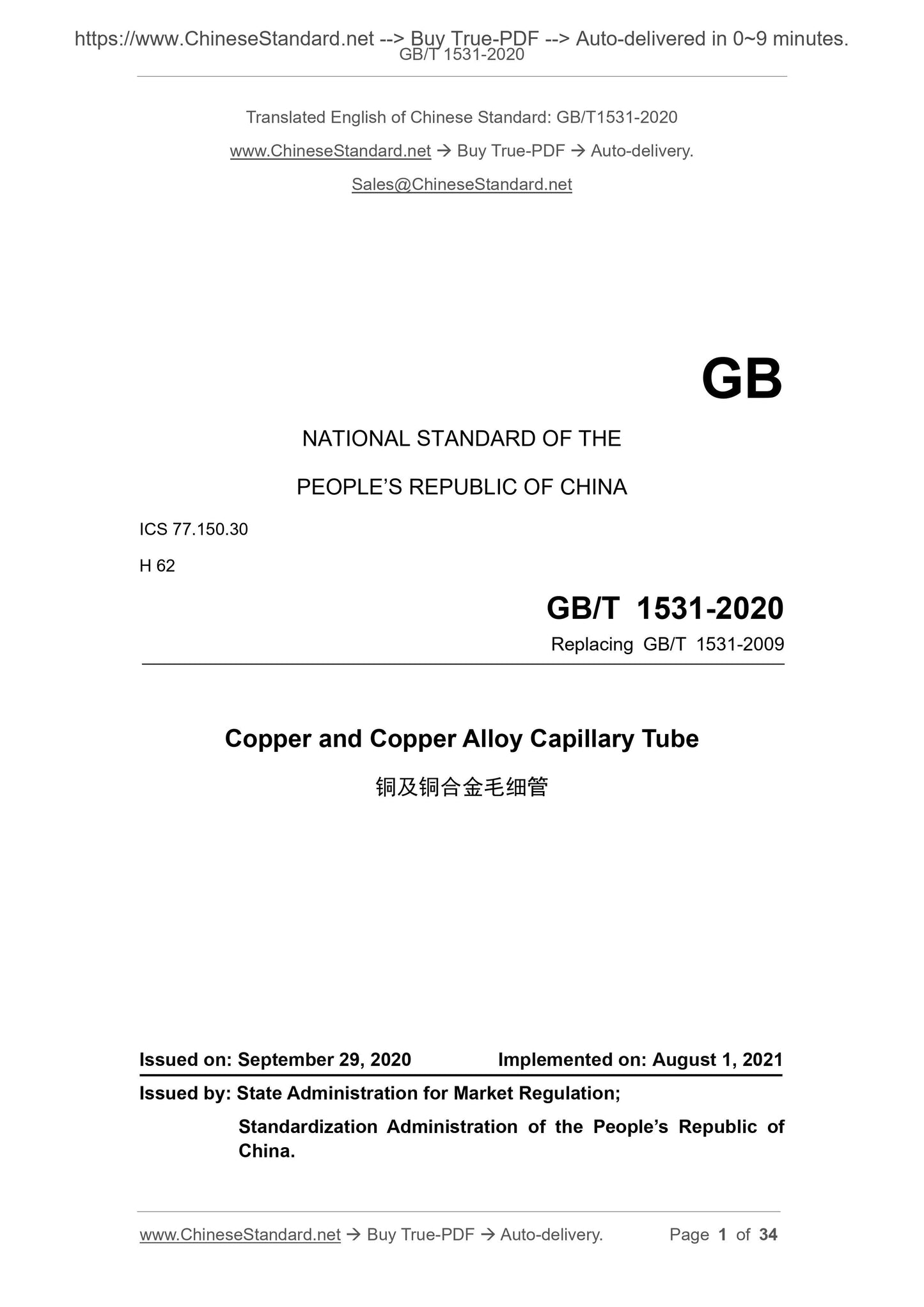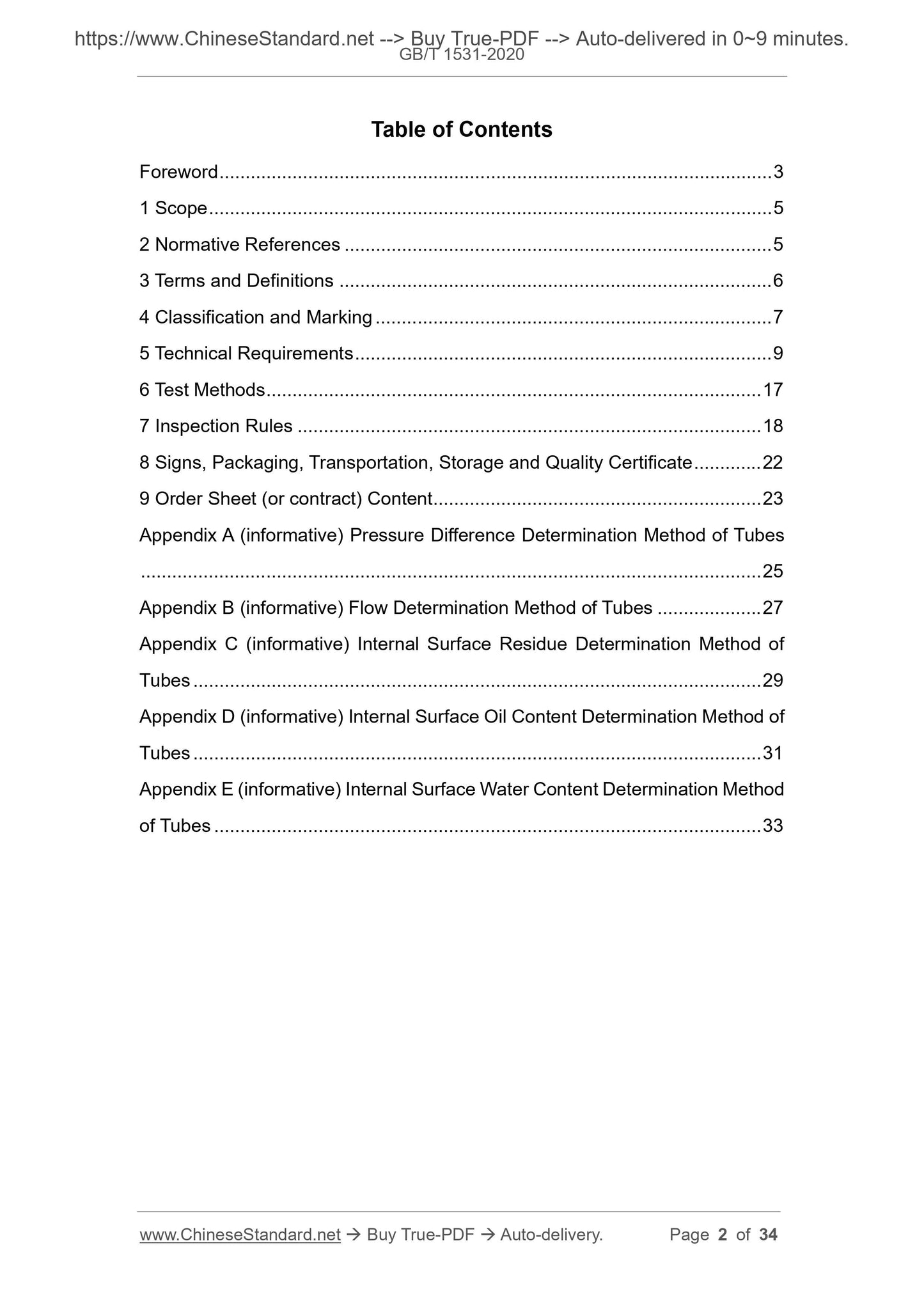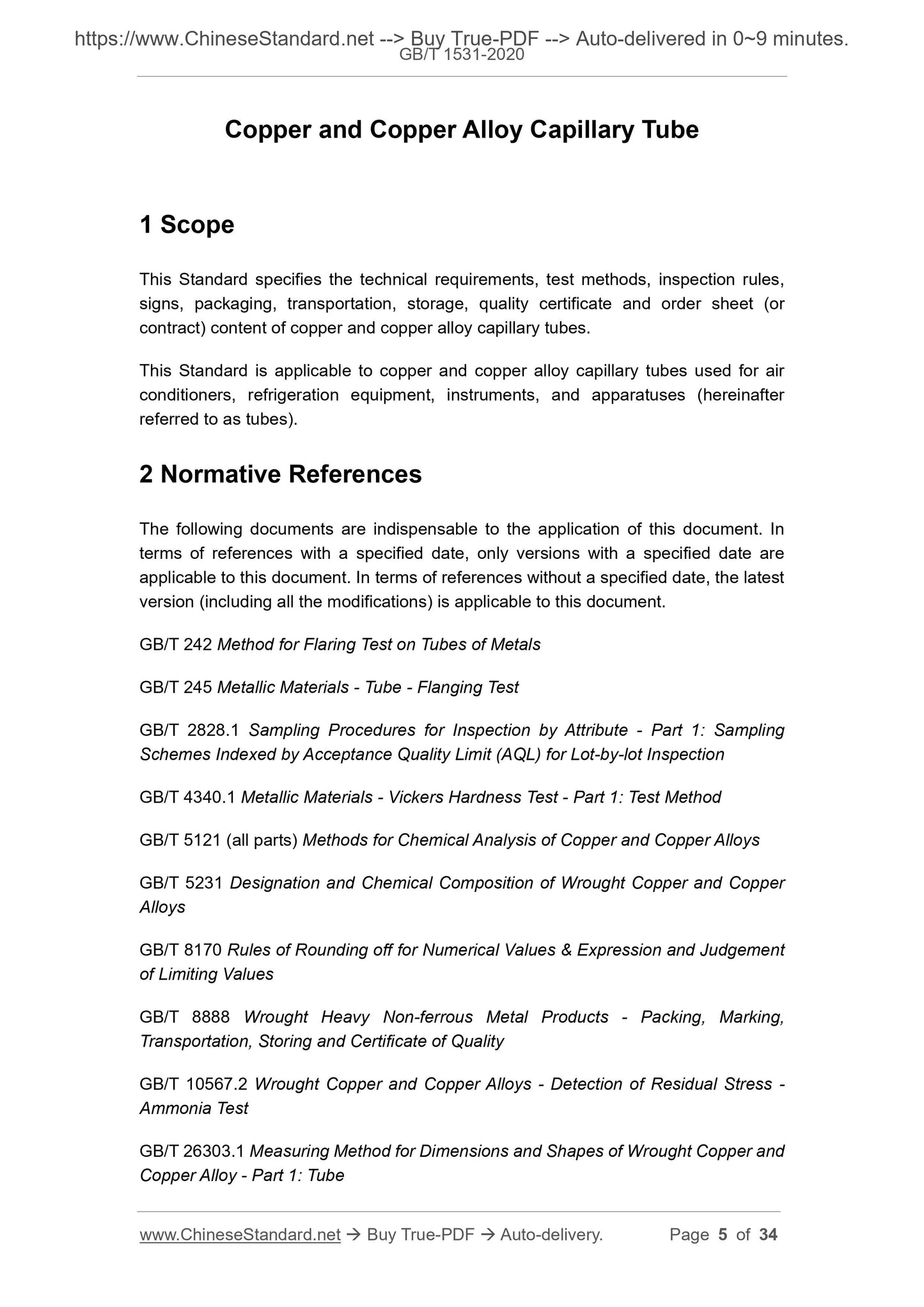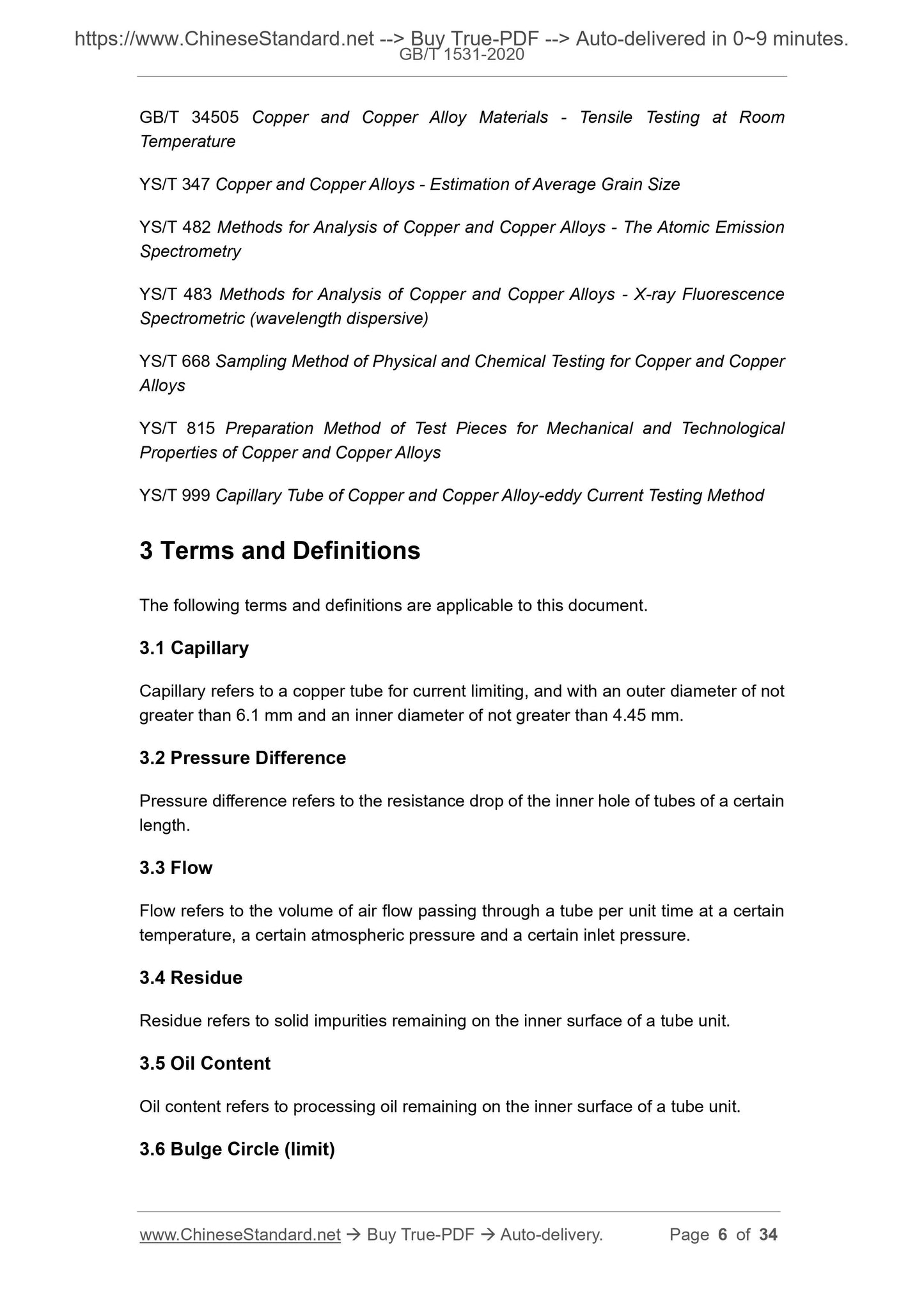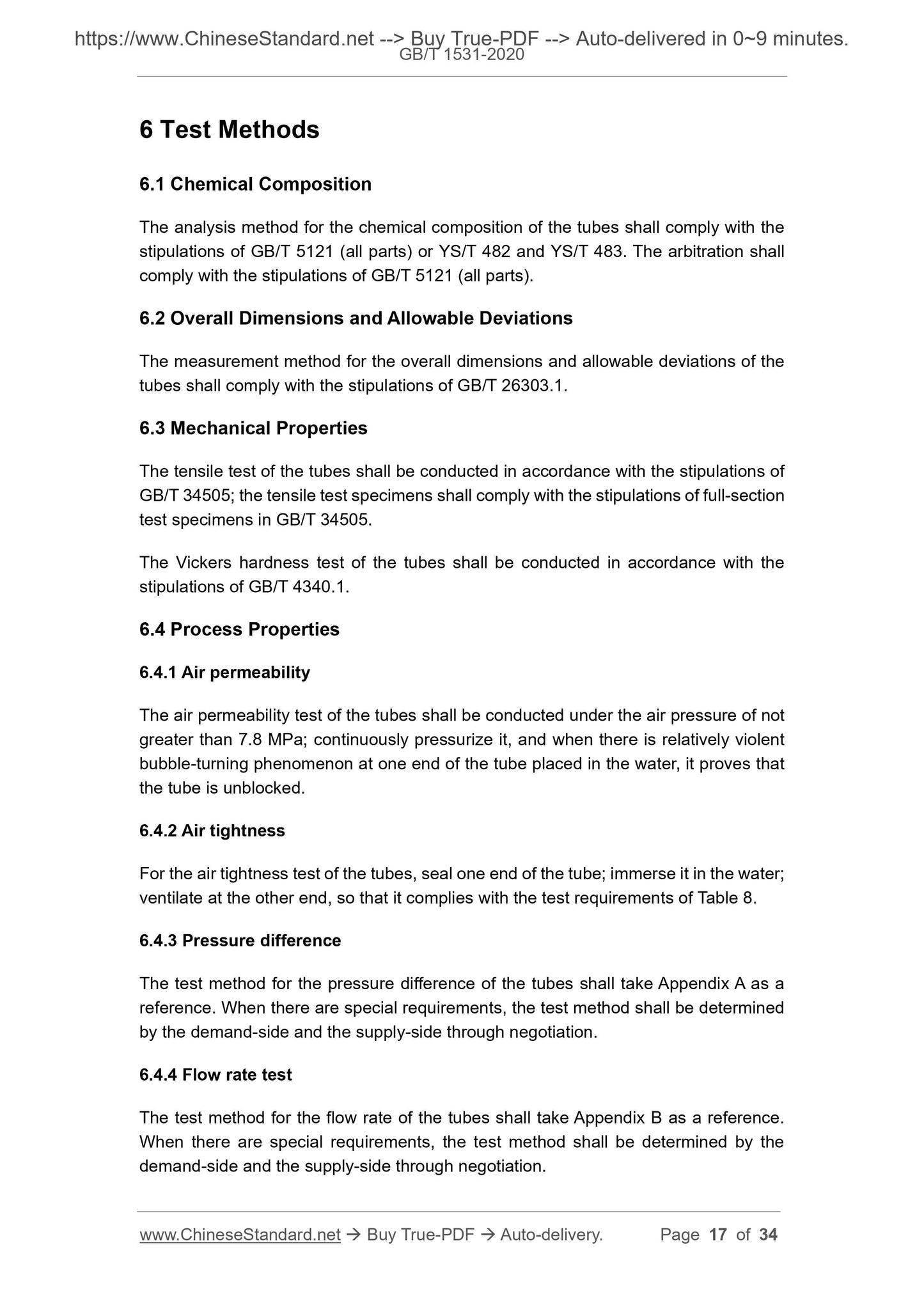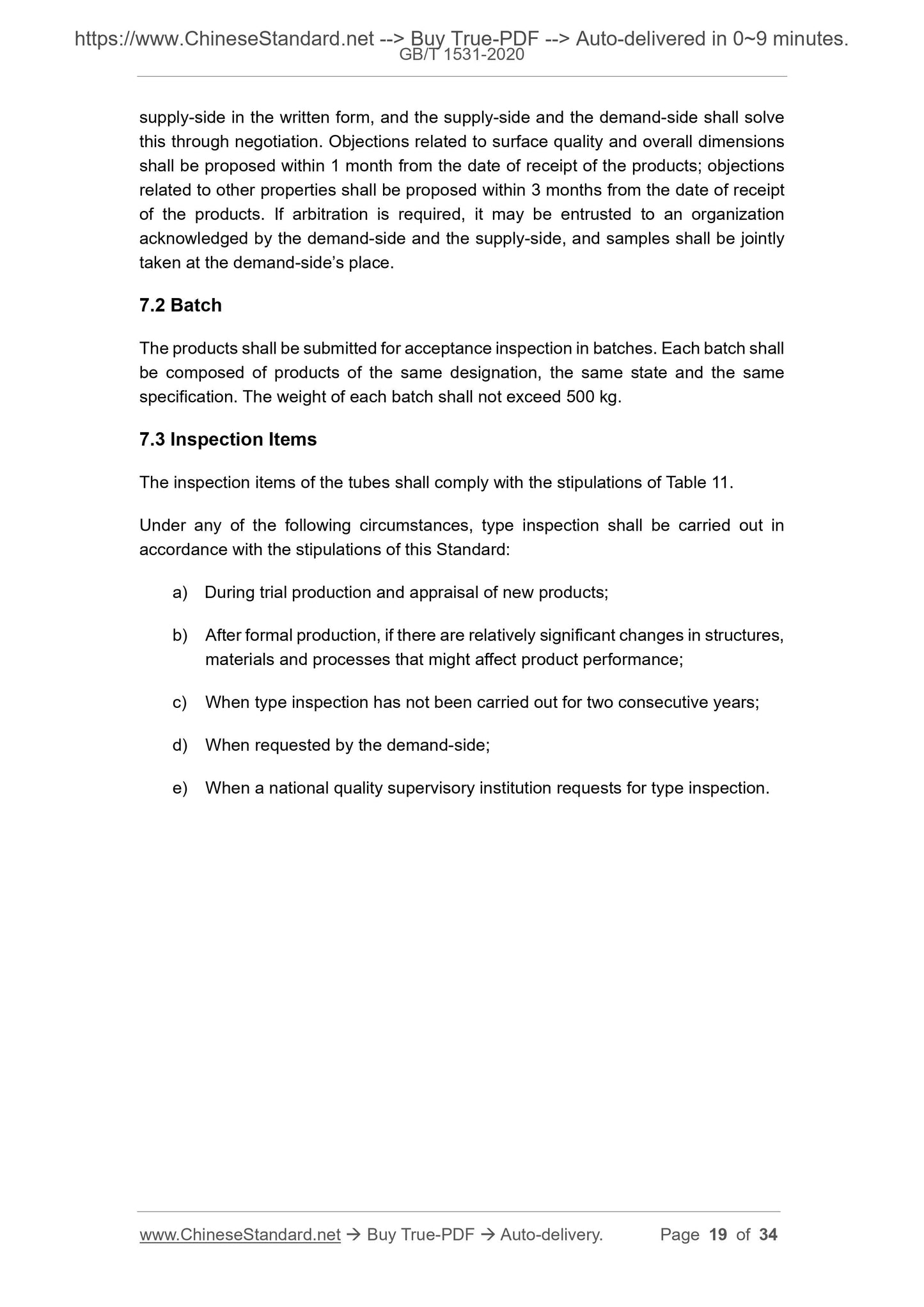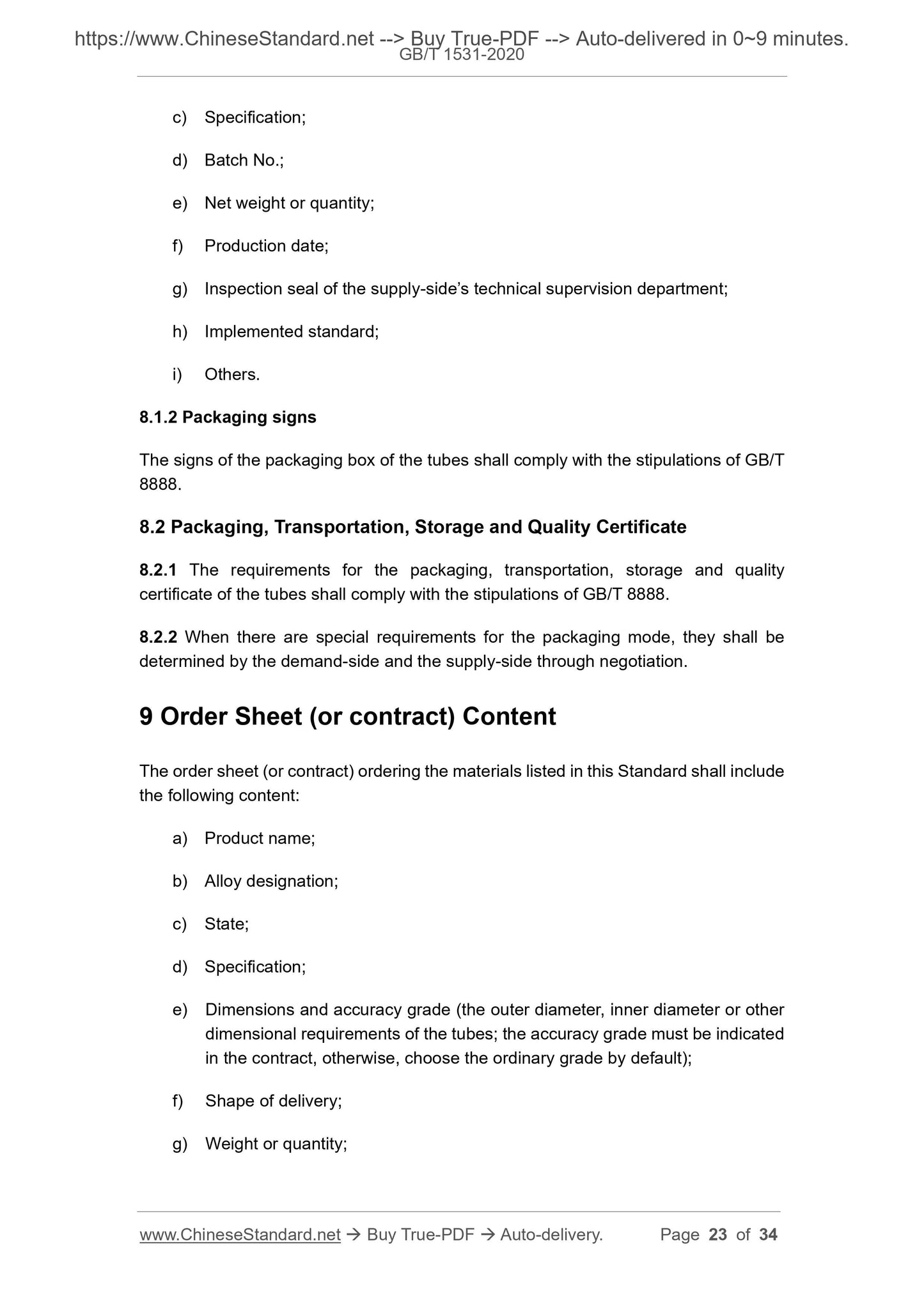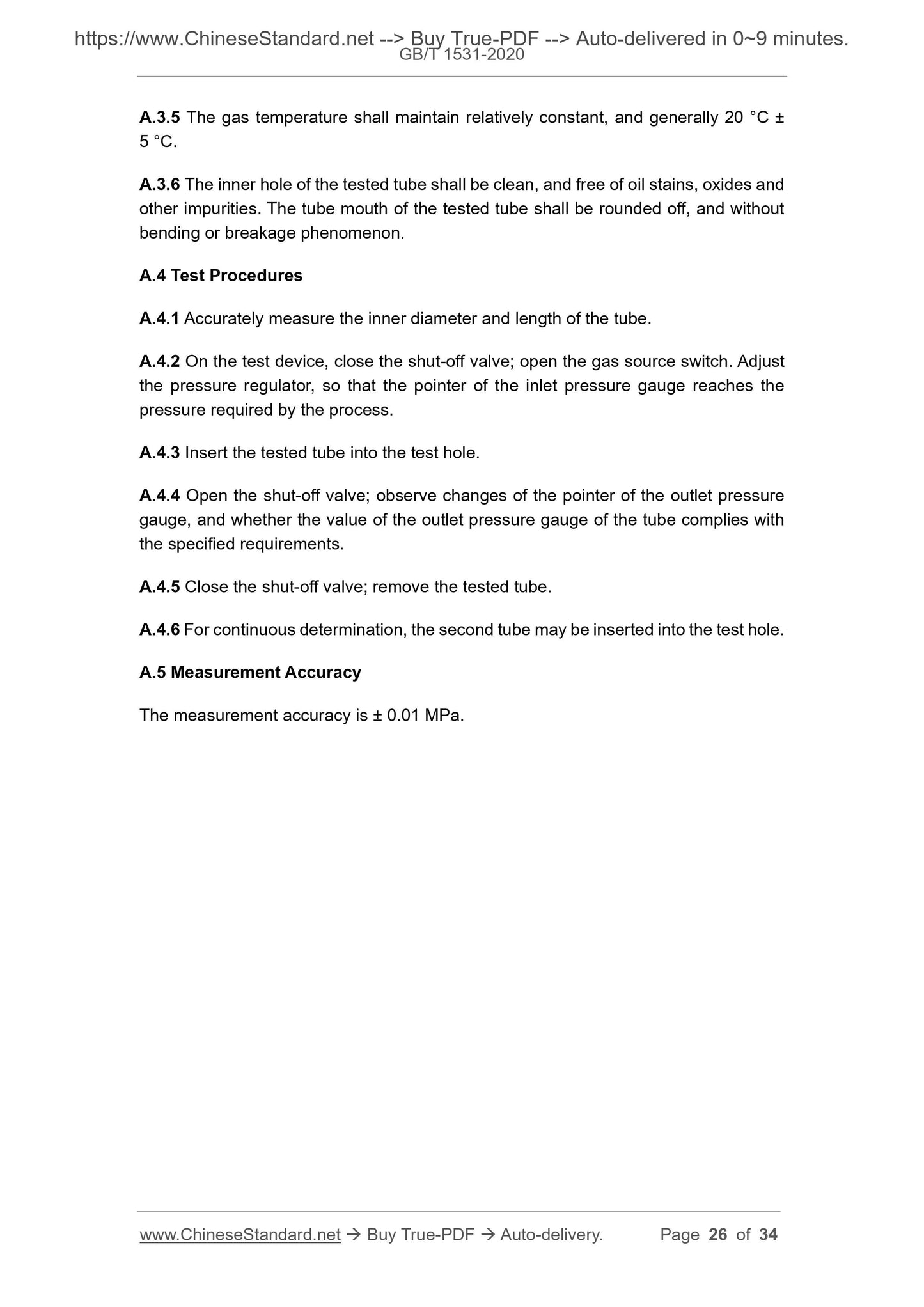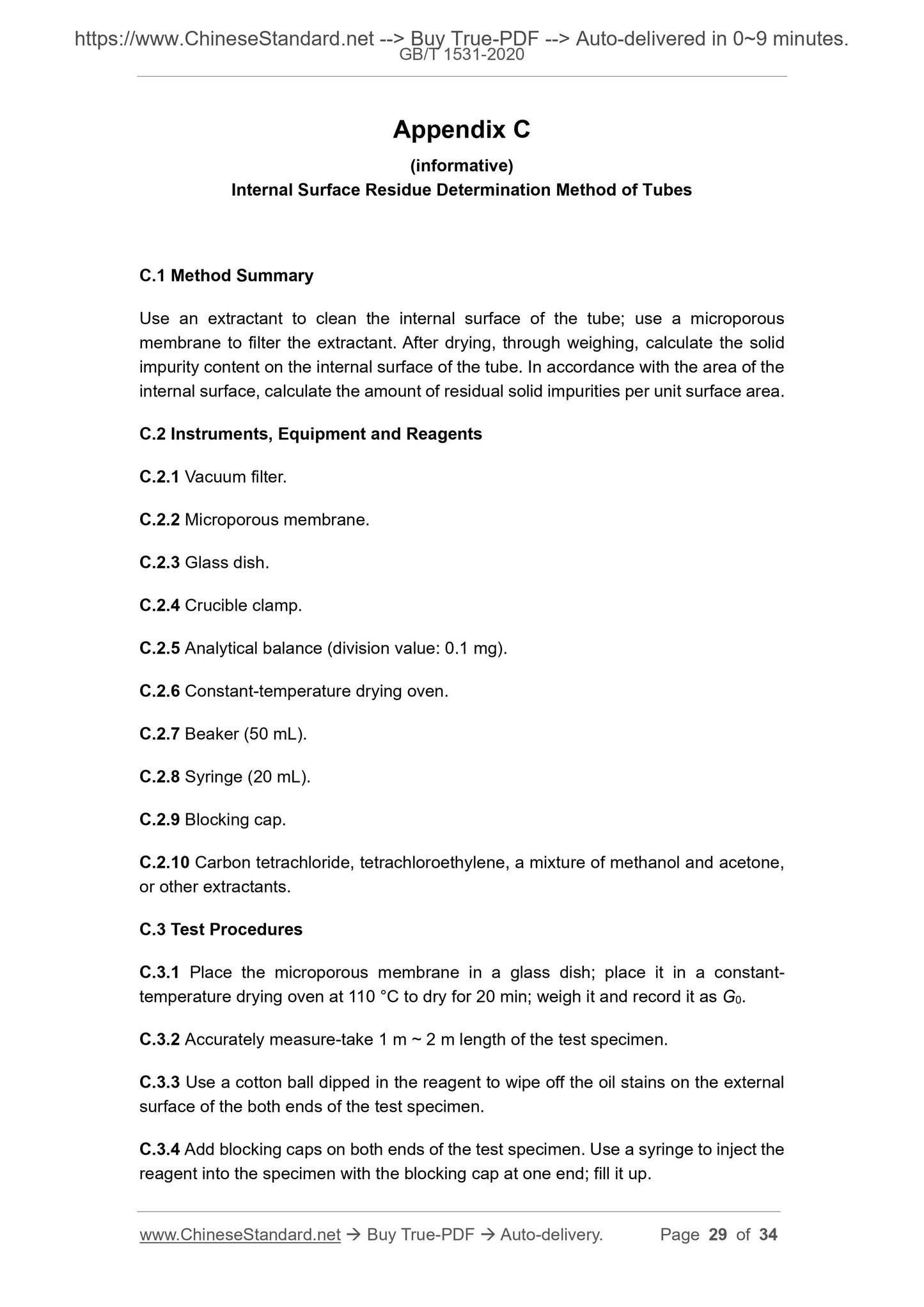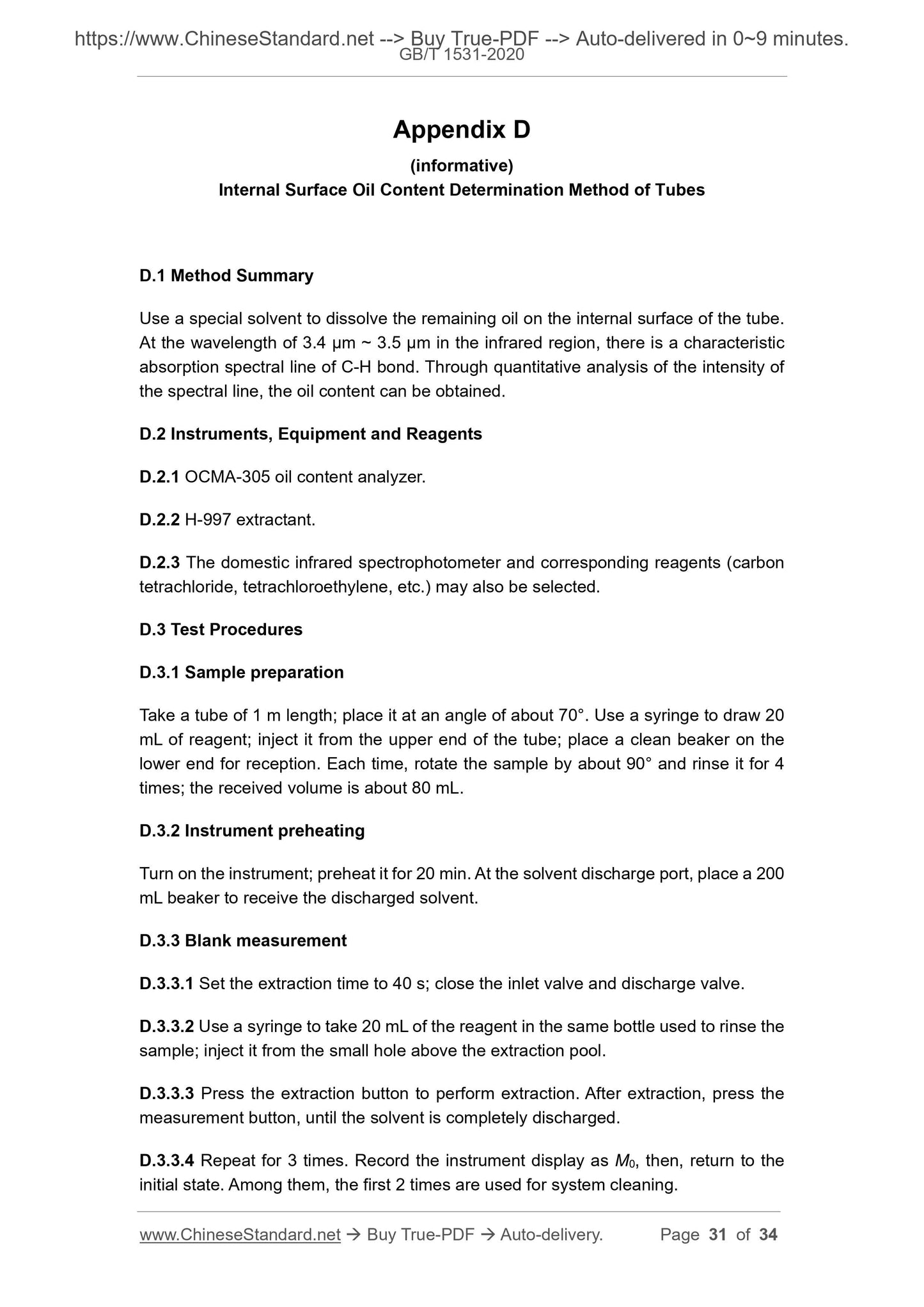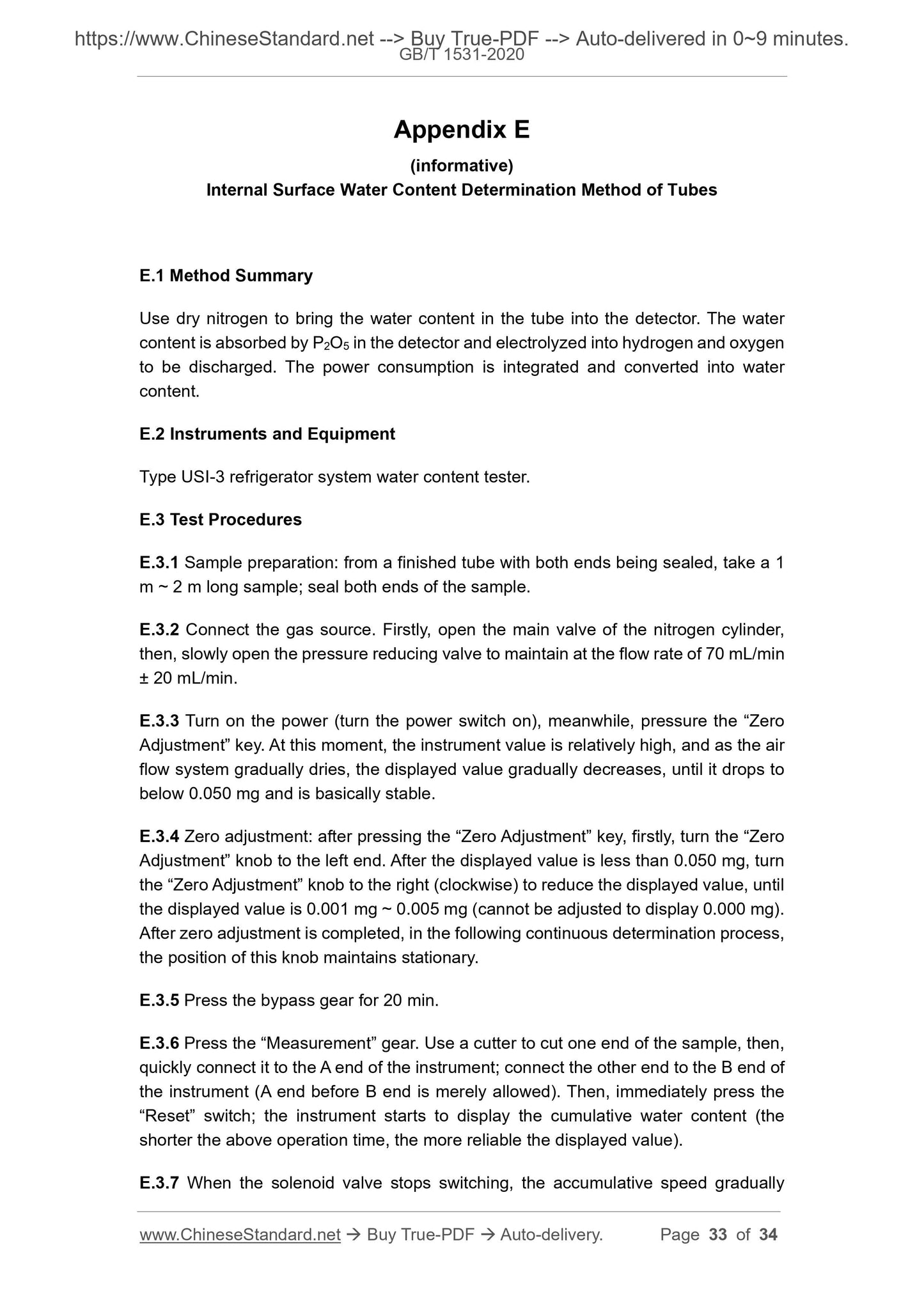1
/
of
11
PayPal, credit cards. Download editable-PDF and invoice in 1 second!
GB/T 1531-2020 English PDF (GB/T1531-2020)
GB/T 1531-2020 English PDF (GB/T1531-2020)
Regular price
$345.00 USD
Regular price
Sale price
$345.00 USD
Unit price
/
per
Shipping calculated at checkout.
Couldn't load pickup availability
Delivery: 3 seconds. Download true-PDF + Invoice.
Get QUOTATION in 1-minute: Click GB/T 1531-2020
Historical versions: GB/T 1531-2020
Preview True-PDF (Reload/Scroll if blank)
GB/T 1531-2020: Copper and copper alloy capillary tube
GB/T 1531-2020
GB
NATIONAL STANDARD OF THE
PEOPLE’S REPUBLIC OF CHINA
ICS 77.150.30
H 62
Replacing GB/T 1531-2009
Copper and Copper Alloy Capillary Tube
ISSUED ON: SEPTEMBER 29, 2020
IMPLEMENTED ON: AUGUST 1, 2021
Issued by: State Administration for Market Regulation;
Standardization Administration of the People’s Republic of
China.
Table of Contents
Foreword ... 3
1 Scope ... 5
2 Normative References ... 5
3 Terms and Definitions ... 6
4 Classification and Marking ... 7
5 Technical Requirements ... 9
6 Test Methods ... 17
7 Inspection Rules ... 18
8 Signs, Packaging, Transportation, Storage and Quality Certificate ... 22
9 Order Sheet (or contract) Content ... 23
Appendix A (informative) Pressure Difference Determination Method of Tubes
... 25
Appendix B (informative) Flow Determination Method of Tubes ... 27
Appendix C (informative) Internal Surface Residue Determination Method of
Tubes ... 29
Appendix D (informative) Internal Surface Oil Content Determination Method of
Tubes ... 31
Appendix E (informative) Internal Surface Water Content Determination Method
of Tubes ... 33
Copper and Copper Alloy Capillary Tube
1 Scope
This Standard specifies the technical requirements, test methods, inspection rules,
signs, packaging, transportation, storage, quality certificate and order sheet (or
contract) content of copper and copper alloy capillary tubes.
This Standard is applicable to copper and copper alloy capillary tubes used for air
conditioners, refrigeration equipment, instruments, and apparatuses (hereinafter
referred to as tubes).
2 Normative References
The following documents are indispensable to the application of this document. In
terms of references with a specified date, only versions with a specified date are
applicable to this document. In terms of references without a specified date, the latest
version (including all the modifications) is applicable to this document.
GB/T 242 Method for Flaring Test on Tubes of Metals
GB/T 245 Metallic Materials - Tube - Flanging Test
GB/T 2828.1 Sampling Procedures for Inspection by Attribute - Part 1: Sampling
Schemes Indexed by Acceptance Quality Limit (AQL) for Lot-by-lot Inspection
GB/T 4340.1 Metallic Materials - Vickers Hardness Test - Part 1: Test Method
GB/T 5121 (all parts) Methods for Chemical Analysis of Copper and Copper Alloys
GB/T 5231 Designation and Chemical Composition of Wrought Copper and Copper
Alloys
GB/T 8170 Rules of Rounding off for Numerical Values and Expression and Judgement
of Limiting Values
GB/T 8888 Wrought Heavy Non-ferrous Metal Products - Packing, Marking,
Transportation, Storing and Certificate of Quality
GB/T 10567.2 Wrought Copper and Copper Alloys - Detection of Residual Stress -
Ammonia Test
GB/T 26303.1 Measuring Method for Dimensions and Shapes of Wrought Copper and
Copper Alloy - Part 1: Tube
GB/T 34505 Copper and Copper Alloy Materials - Tensile Testing at Room
Temperature
YS/T 347 Copper and Copper Alloys - Estimation of Average Grain Size
YS/T 482 Methods for Analysis of Copper and Copper Alloys - The Atomic Emission
Spectrometry
YS/T 483 Methods for Analysis of Copper and Copper Alloys - X-ray Fluorescence
Spectrometric (wavelength dispersive)
YS/T 668 Sampling Method of Physical and Chemical Testing for Copper and Copper
Alloys
YS/T 815 Preparation Method of Test Pieces for Mechanical and Technological
Properties of Copper and Copper Alloys
YS/T 999 Capillary Tube of Copper and Copper Alloy-eddy Current Testing Method
3 Terms and Definitions
The following terms and definitions are applicable to this document.
3.1 Capillary
Capillary refers to a copper tube for current limiting, and with an outer diameter of not
greater than 6.1 mm and an inner diameter of not greater than 4.45 mm.
3.2 Pressure Difference
Pressure difference refers to the resistance drop of the inner hole of tubes of a certain
length.
3.3 Flow
Flow refers to the volume of air flow passing through a tube per unit time at a certain
temperature, a certain atmospheric pressure and a certain inlet pressure.
3.4 Residue
Residue refers to solid impurities remaining on the inner surface of a tube unit.
3.5 Oil Content
Oil content refers to processing oil remaining on the inner surface of a tube unit.
3.6 Bulge Circle (limit)
6 Test Methods
6.1 Chemical Composition
The analysis method for the chemical composition of the tubes shall comply with the
stipulations of GB/T 5121 (all parts) or YS/T 482 and YS/T 483. The arbitration shall
comply with the stipulations of GB/T 5121 (all parts).
6.2 Overall Dimensions and Allowable Deviations
The measurement method for the overall dimensions and allowable deviations of the
tubes shall comply with the stipulations of GB/T 26303.1.
6.3 Mechanical Properties
The tensile test of the tubes shall be conducted in accordance with the stipulations of
GB/T 34505; the tensile test specimens shall comply with the stipulations of full-section
test specimens in GB/T 34505.
The Vickers hardness test of the tubes shall be conducted in accordance with the
stipulations of GB/T 4340.1.
6.4 Process Properties
6.4.1 Air permeability
The air permeability test of the tubes shall be conducted under the air pressure of not
greater than 7.8 MPa; continuously pressurize it, and when there is relatively violent
bubble-turning phenomenon at one end of the tube placed in the water, it proves that
the tube is unblocked.
6.4.2 Air tightness
For the air tightness test of the tubes, seal one end of the tube; immerse it in the water;
ventilate at the other end, so that it complies with the test requirements of Table 8.
6.4.3 Pressure difference
The test method for the pressure difference of the tubes shall take Appendix A as a
reference. When there are special requirements, the test method shall be determined
by the demand-side and the supply-side through negotiation.
6.4.4 Flow rate test
The test method for the flow rate of the tubes shall take Appendix B as a reference.
When there are special requirements, the test method shall be determined by the
demand-side and the supply-side through negotiation.
supply-side in the written form, and the supply-side and the demand-side shall solve
this through negotiation. Objections related to surface quality and overall dimensions
shall be proposed within 1 month from the date of receipt of the products; objections
related to other properties shall be proposed within 3 months from the date of receipt
of the products. If arbitration is required, it may be entrusted to an organization
acknowledged by the demand-side and the supply-side, and samples shall be jointly
taken at the demand-side’s place.
7.2 Batch
The products shall be submitted for acceptance inspection in batches. Each batch shall
be composed of products of the same designation, the same state and the same
specification. The weight of each batch shall not exceed 500 kg.
7.3 Inspection Items
The inspection items of the tubes shall comply with the stipulations of Table 11.
Under any of the following circumstances, type inspection shall be carried out in
accordance with the stipulations of this Standard:
a) During trial production and appraisal of new products;
b) After formal production, if there are relatively significant changes in structures,
materials and processes that might affect product performance; <...
Get QUOTATION in 1-minute: Click GB/T 1531-2020
Historical versions: GB/T 1531-2020
Preview True-PDF (Reload/Scroll if blank)
GB/T 1531-2020: Copper and copper alloy capillary tube
GB/T 1531-2020
GB
NATIONAL STANDARD OF THE
PEOPLE’S REPUBLIC OF CHINA
ICS 77.150.30
H 62
Replacing GB/T 1531-2009
Copper and Copper Alloy Capillary Tube
ISSUED ON: SEPTEMBER 29, 2020
IMPLEMENTED ON: AUGUST 1, 2021
Issued by: State Administration for Market Regulation;
Standardization Administration of the People’s Republic of
China.
Table of Contents
Foreword ... 3
1 Scope ... 5
2 Normative References ... 5
3 Terms and Definitions ... 6
4 Classification and Marking ... 7
5 Technical Requirements ... 9
6 Test Methods ... 17
7 Inspection Rules ... 18
8 Signs, Packaging, Transportation, Storage and Quality Certificate ... 22
9 Order Sheet (or contract) Content ... 23
Appendix A (informative) Pressure Difference Determination Method of Tubes
... 25
Appendix B (informative) Flow Determination Method of Tubes ... 27
Appendix C (informative) Internal Surface Residue Determination Method of
Tubes ... 29
Appendix D (informative) Internal Surface Oil Content Determination Method of
Tubes ... 31
Appendix E (informative) Internal Surface Water Content Determination Method
of Tubes ... 33
Copper and Copper Alloy Capillary Tube
1 Scope
This Standard specifies the technical requirements, test methods, inspection rules,
signs, packaging, transportation, storage, quality certificate and order sheet (or
contract) content of copper and copper alloy capillary tubes.
This Standard is applicable to copper and copper alloy capillary tubes used for air
conditioners, refrigeration equipment, instruments, and apparatuses (hereinafter
referred to as tubes).
2 Normative References
The following documents are indispensable to the application of this document. In
terms of references with a specified date, only versions with a specified date are
applicable to this document. In terms of references without a specified date, the latest
version (including all the modifications) is applicable to this document.
GB/T 242 Method for Flaring Test on Tubes of Metals
GB/T 245 Metallic Materials - Tube - Flanging Test
GB/T 2828.1 Sampling Procedures for Inspection by Attribute - Part 1: Sampling
Schemes Indexed by Acceptance Quality Limit (AQL) for Lot-by-lot Inspection
GB/T 4340.1 Metallic Materials - Vickers Hardness Test - Part 1: Test Method
GB/T 5121 (all parts) Methods for Chemical Analysis of Copper and Copper Alloys
GB/T 5231 Designation and Chemical Composition of Wrought Copper and Copper
Alloys
GB/T 8170 Rules of Rounding off for Numerical Values and Expression and Judgement
of Limiting Values
GB/T 8888 Wrought Heavy Non-ferrous Metal Products - Packing, Marking,
Transportation, Storing and Certificate of Quality
GB/T 10567.2 Wrought Copper and Copper Alloys - Detection of Residual Stress -
Ammonia Test
GB/T 26303.1 Measuring Method for Dimensions and Shapes of Wrought Copper and
Copper Alloy - Part 1: Tube
GB/T 34505 Copper and Copper Alloy Materials - Tensile Testing at Room
Temperature
YS/T 347 Copper and Copper Alloys - Estimation of Average Grain Size
YS/T 482 Methods for Analysis of Copper and Copper Alloys - The Atomic Emission
Spectrometry
YS/T 483 Methods for Analysis of Copper and Copper Alloys - X-ray Fluorescence
Spectrometric (wavelength dispersive)
YS/T 668 Sampling Method of Physical and Chemical Testing for Copper and Copper
Alloys
YS/T 815 Preparation Method of Test Pieces for Mechanical and Technological
Properties of Copper and Copper Alloys
YS/T 999 Capillary Tube of Copper and Copper Alloy-eddy Current Testing Method
3 Terms and Definitions
The following terms and definitions are applicable to this document.
3.1 Capillary
Capillary refers to a copper tube for current limiting, and with an outer diameter of not
greater than 6.1 mm and an inner diameter of not greater than 4.45 mm.
3.2 Pressure Difference
Pressure difference refers to the resistance drop of the inner hole of tubes of a certain
length.
3.3 Flow
Flow refers to the volume of air flow passing through a tube per unit time at a certain
temperature, a certain atmospheric pressure and a certain inlet pressure.
3.4 Residue
Residue refers to solid impurities remaining on the inner surface of a tube unit.
3.5 Oil Content
Oil content refers to processing oil remaining on the inner surface of a tube unit.
3.6 Bulge Circle (limit)
6 Test Methods
6.1 Chemical Composition
The analysis method for the chemical composition of the tubes shall comply with the
stipulations of GB/T 5121 (all parts) or YS/T 482 and YS/T 483. The arbitration shall
comply with the stipulations of GB/T 5121 (all parts).
6.2 Overall Dimensions and Allowable Deviations
The measurement method for the overall dimensions and allowable deviations of the
tubes shall comply with the stipulations of GB/T 26303.1.
6.3 Mechanical Properties
The tensile test of the tubes shall be conducted in accordance with the stipulations of
GB/T 34505; the tensile test specimens shall comply with the stipulations of full-section
test specimens in GB/T 34505.
The Vickers hardness test of the tubes shall be conducted in accordance with the
stipulations of GB/T 4340.1.
6.4 Process Properties
6.4.1 Air permeability
The air permeability test of the tubes shall be conducted under the air pressure of not
greater than 7.8 MPa; continuously pressurize it, and when there is relatively violent
bubble-turning phenomenon at one end of the tube placed in the water, it proves that
the tube is unblocked.
6.4.2 Air tightness
For the air tightness test of the tubes, seal one end of the tube; immerse it in the water;
ventilate at the other end, so that it complies with the test requirements of Table 8.
6.4.3 Pressure difference
The test method for the pressure difference of the tubes shall take Appendix A as a
reference. When there are special requirements, the test method shall be determined
by the demand-side and the supply-side through negotiation.
6.4.4 Flow rate test
The test method for the flow rate of the tubes shall take Appendix B as a reference.
When there are special requirements, the test method shall be determined by the
demand-side and the supply-side through negotiation.
supply-side in the written form, and the supply-side and the demand-side shall solve
this through negotiation. Objections related to surface quality and overall dimensions
shall be proposed within 1 month from the date of receipt of the products; objections
related to other properties shall be proposed within 3 months from the date of receipt
of the products. If arbitration is required, it may be entrusted to an organization
acknowledged by the demand-side and the supply-side, and samples shall be jointly
taken at the demand-side’s place.
7.2 Batch
The products shall be submitted for acceptance inspection in batches. Each batch shall
be composed of products of the same designation, the same state and the same
specification. The weight of each batch shall not exceed 500 kg.
7.3 Inspection Items
The inspection items of the tubes shall comply with the stipulations of Table 11.
Under any of the following circumstances, type inspection shall be carried out in
accordance with the stipulations of this Standard:
a) During trial production and appraisal of new products;
b) After formal production, if there are relatively significant changes in structures,
materials and processes that might affect product performance; <...
Share
